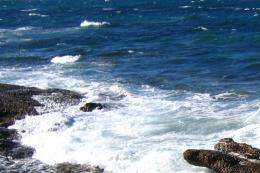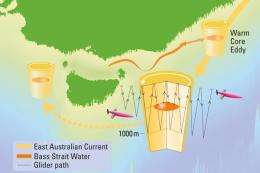A secret hidden in Australia's ocean eddies

Deep-diving ocean "gliders" have revealed the journey of Bass Strait water from the Tasman Sea to the Indian Ocean.
Deployed in 2010 and 2011, the gliders have also profiled a 200-metre tall wall of water at the core of long-lived ocean eddies formed from the East Australian Current.
The study, by UTS and CSIRO oceanographers, revealed the value of new sensors being deployed by Australia's Integrated Marine Observing System.
"We're getting a terrific amount of data that is opening up a very big window on Australia's oceans," UTS scientist Dr. Mark Baird said.
Dr. Baird was the lead author of a paper published this week in Geophysical Research Letters. Dr. Baird is a Research Fellow with the UTS Plant Functional Biology and Climate Change Cluster and a member of the C3 Coastal Oceanography Team.
"In this case, we have seen for the first time a 200-meter tall, 40 kilometer wide disc formed from water that originated in Bass Strait that amazingly remains undiluted as it travels hundreds of kilometers," he said.

"This new discovery is a clear example of the benefits arising from a significantly enhanced technical ability to explore our oceans and identify features relevant to marine ecosystems and climate."
Scientists have known that salty Bass Strait water, with its unique chemical signature, flows into the Tasman Sea north-east of Flinders Island, sinking to a depth of 400-800 metres in a feature referred to as the Bass Strait Cascade.
However, the porpoising action of the $200,000 pre-programmed ocean gliders has given scientists data to a depth of 1000 metres and a detailed insight into anti-clockwise rotating warm-core eddies that regulate ocean conditions and influence the ocean food chain.
Co-author and leader of these Integrated Marine Observing System deployments, CSIRO Wealth from Oceans scientist Ken Ridgway, said the gliders were programmed to sample across the East Australian Current and through long-lived ocean eddies up to 200 kilometres across that form off New South Wales.
"East of Tasmania, we found bodies of water entrained in the ocean eddies that were originally formed six months previously in Bass Strait and that were up to 40 kilometres wide and 200-300 metres in height," Mr. Ridgway said.
"Further measurements show that at least some of this Bass Strait water makes the journey past southern Tasmania and possibly thousands of kilometres into the Indian Ocean."
The $230M Integrated Marine Observing System has successfully deployed a range of observing equipment in the oceans around Australia, and is making all of the data freely and openly available through the IMOS Ocean Portal for the benefit of Australian marine and climate science as a whole.
The Bass Strait study was part-funded through the Australian Climate Change Science Program, a joint initiative of CSIRO, the Bureau of Meteorology and the Department of Climate Change and Energy Efficiency with further support from the Australian Research Council and the Sydney Institute of Marine Science.
IMOS is supported by the Australian Government through the National Collaborative Research Infrastructure Strategy and the Super Science Initiative.
Provided by University of Technology, Sydney




















